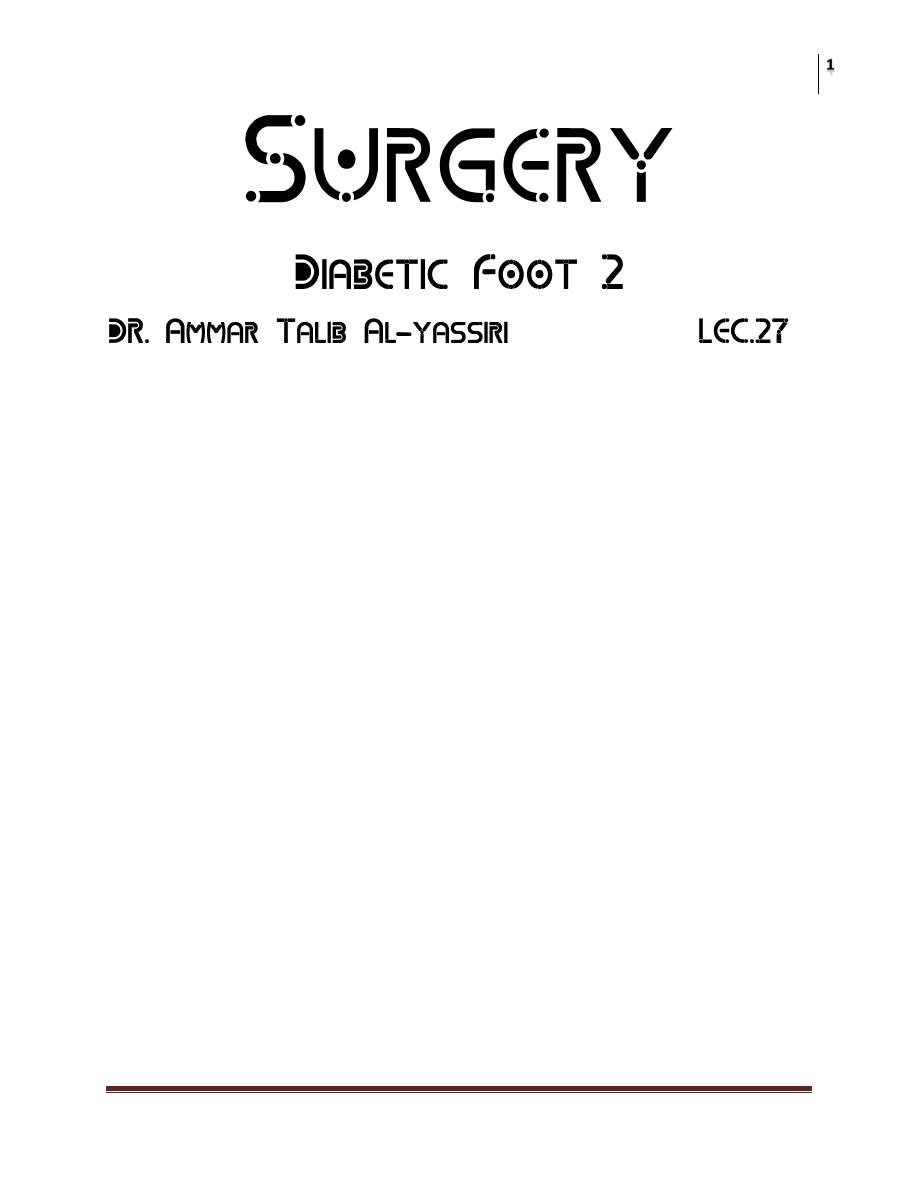
Surgery
Diabetic Foot 2
Dr. Ammar Talib Al-Yassiri
Lec. 27
Patient at risk for diabetic foot ulcers
Peripheral neuropathy.
Peripheral vascular disease
Past history of foot ulcer.
Foot deformity
Poor visual acuity
Elderly patient living alone.
Smokers and alcoholics
Risk factors for diabetic foot infections
Wounds that penetrated to bone
Wounds with duration> 30 days
Recurrent wounds
Wounds with a traumatic etiology and the presence of peripheral vascular
disease
Neuropathy and history of previous amputation as significant risk factors for
infection
Prevention:
The best way of preventing complications is to insist on regular attendance
at a diabetic clinic.
Full compliance with medication

Surgery
Diabetic Foot 2
Dr. Ammar Talib Al-Yassiri
Lec. 27
Examination for early signs of vascular or neurological abnormality.
Advice on foot care and footwear and a high level of skin hygiene.
Foot care for the at risk patients
To do list:
Inspect the foot daily using a mirror to see the sole and
Don’t forget between the fingers.
Wash feet daily
Apply lotion to avoid skin cracks and if present skin cracks should be kept
clean and covered
Use a comfortable shoe wear and change it often
Inspect shoes before wearing it from inside and outside. *Great care is
needed with nail trimming
Not to do list:
Smoking
Step into bath tub without checking the temperature of the water.
Use hot water bottles or heating pad.
Use keratolytic agent to treat the calluses or corn.
Wearing tight shoes or stocking.
walking with barefeet
Management:
For the management of diabetic foot there should be a multidisciplinary team
comprising a physician (or endocrinologist) ,orthopaedic surgeon, surgeon,
chiropodist and orthotist.
Evaluation of diabetic foot patient
Peripheral neuropathy:
Sensory: Examination for early signs of neuropathy should include the use of
Semmes-Weinstein hairs (for testing skin sensibility)
biothesiometer(for testing vibration sense),
Thermal discrimination test, and joint position sense.

Surgery
Diabetic Foot 2
Dr. Ammar Talib Al-Yassiri
Lec. 27
Motor: examine for wasting, weakness, absent or diminished tendon reflex, and
this can be enhanced by the EMG&N/C study.
Peripheral vascular damage:
examine for
The pulses,
Skin temperature,
Trophic changes in the skin and nails and deformities (claw toes, hammer
toes, pes cavus).
Peripheral vascular examination is enhanced by using
Doppler ultrasound probe,
ankle brachial index measurement,
transcutaneous oxygen measurement,
Angiography.
Infection:
examine for
The local and systemic signs of infection.
Ulcers must be swabbed for infecting organisms.
Magnetic resonance imaging (MRI) is the most specific and sensitive non-
invasive test to evaluate OM and is also useful for the evaluation of a
probable abscess or sinus tract formation.
Bone scans, such as the white blood cell labeled Indium-111, Technetium-99
and Sulfur Colloid Marrow Scan, may prove beneficial between
distinguishing acute and chronic infections, also it is useful for identifying
OM from Charcot neuroarthropathy
Osteopathy:
examine for
Charcot deformities (flatening of the foot arches, rocker-bottom deformity,
prominent metatarsl heads.
X-ray examination may reveal periosteal reactions, osteoporosis, cortical
defects near the articular margins and osteolysis - often collectively
described as 'diabetic osteopathy

Surgery
Diabetic Foot 2
Dr. Ammar Talib Al-Yassiri
Lec. 27
Laboratory investigations
WBC elevated in 50% of patients.
Renal function,
Electrolytes,
Acidosis,
Blood glucose level.
Hemoglobin A1C levels provide a barometer of glycemic control averaged
over the previous 2-3 months.
Acute phase reactants ESR &CRP (baseline and post-treatment CRP, ESR
and WBC were significantly elevated in patients who ultimately required
amputation).
Serum prealbumin and albumin, well known as determinants of nutritional
status.
microbiological analysis permits the appropriate selection of antimicrobial
therapy
Treatment
According to wagner classification:
Grade 0 (skin intact): calluses should be trimmed so as not mask active
ulcer, advise the patient how to do &daily foot care and apply the
preventive measures.
Grade 1&2(superficial & deep ulcer but without infection ): the aim here is
to heal the skin, after desloughing the ulcer and removing the hyper keratotic
skin the ulcer can be dressed locally, the application of a skin - tight
POP(total contact cast) changed weekly will allow most of the ulcers to heal.
It also allows the patient to be mobile

Surgery
Diabetic Foot 2
Dr. Ammar Talib Al-Yassiri
Lec. 27
Grad 3 (grade2 with infection):deep infecion without abscess formation can
be treated by
strict rest, elevation soft tissue support and AB.
Any form of abscess formation needs to be drained urgently and the
deeper tissues throughly debrided. Deep ulcers in certain sites are
more problematic than elswhere .
Once an ulcer is healed the use of appropriate insoles and shoes can
prevent further ulceration.
Grade 4(localized gangrene):
Ischaemic changes need the attention of a vascular surgeon who can
advise on ways of improving the local blood supply. Arteriography
may show that bypass surgery is feasible.
Dry gangrene of the toe can be allowed to demarcate before local
amputation.
With diabetic gangrene septic arithritis is not uncommon , the entire
ray(toe+metatarsal bone ) should be amputated.
In More extensive gangrene partial foot amputation done e.g. through
the midtarsal joints(Chopart),thruogh tarsometatarsal joints(lisfranc),
thruogh metatarsal bone.
Grade 5(Global foot gangrene) :
Severe occlusive disease with wet gangrene may call for immediate
amputation.
This should be undertaken at a level where there is a realistic chance
of the wound healing.

Surgery
Diabetic Foot 2
Dr. Ammar Talib Al-Yassiri
Lec. 27
Treatment of special problems
Ischaemic changes : need the attention of a vascular surgeon who can
advise on ways of improving the local blood supply. Arteriography may
show that bypass surgery is feasible.
Insufficiency fractures: should be treated, if possible, without immobilizing
the limb; or, if a cast is essential, it should be retained for the shortest
possible period.
Fixed foot deformities : corrective surgery should be considered.
Neuropathic joint disease : is a major challenge.
Arthrodesis is fraught with difficulty, not least a very poor union rate, and
sometimes is simply not feasible. 'Containment' of the problem in a weight-
relieving orthosis may be the best option.
